There are three primary organizations representing Koreans living in Japan. They are the “Republic of Korea Residents Union in Japan” 재일본대한민국민단 (在日本大韓民國民團), Korean Association in Japan 재일본한국인연합회 (在日本韓国人連合会), and the “Association of Korean Residents in Japan” 재일본조선인총련합회 (在日本朝鮮人總聯合會). The primary difference between the three is political, with the ROK Residents Union and the Korean Residents in Japan affiliated with South Korea, while the Association of Korean Residents in Japan being allied with North Korea. For a much more in-depth discussion of Koreans in Japan, see the Wikipedia page, “Koreans in Japan”.
Republic of Korea Residents Union in Japan (Korean National Association in Japan)
Shortly after the end of WWII, on Sept. 10, 1945, seven ‘Koreans in Japan’ (Zainichi 재일 한국인) organizations in Tokyo and 60 representatives from each region of Japan gathered to form the ‘Central Committee of the Federation of Koreans in Japan (Training)’ 재일조선인연맹 (조련) 중앙위원회. The Central Committee was created and officially launched on September 20th. However, as the federation came to support the North Korean People’s Committee, right-wing Korean youth in Japan organized the ‘Joseon National Foundation Promotion Youth Alliance (Geoncheong)’ 조선건국촉진청년동맹(건청) in November and the ‘New Joseon Construction Alliance (Geondong)’ 신조선건설동맹(건동) led by Park Yeol 박열 and others in January of the following year.1 These two organizations were merged on October 3 to create the Korean Resident’s Association in Japan 재일본조선인거류민단, laying the foundation for the current association. On August 15, 1948, with the establishment of the Republic of Korea government, the association was recognized as an accredited organization and officially named the Korean Residents Association in Japan 재일본대한민국거류민단 (在日本朝鮮人居留民團). In 1965, according to the Korea-Japan Basic Treaty, permanent residency was allowed for Koreans living in Japan, and the organization’s size expanded as more Koreans immigrated to Japan. In 1994, the two words for ‘Residence’ 居留 were removed, and the name was changed to the current name Korean National Association in Japan 재일본대한민국민단. The number of members is approximately 600,000. However, more and more 2nd and 3rd generation Koreans have chosen Japanese naturalization, and the power base of the organization is gradually eroding. The Republic of Korea Residents Union in Japan 재일본대한민국민단 (在日本大韓民國民團) is more often recognized by the term Mindan 민단. On the dark side, there is also a connection between Mindan and the Korean Yakuza (The Mafia 야쿠자 ヤクザ, やくざ) in Japan.

功勞章 (공로장)

在日本大韓民國民團居留民團
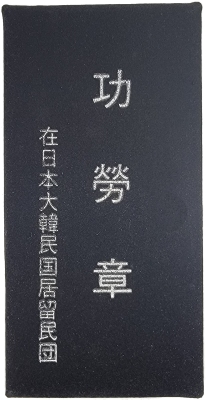
Merit Medal
功勞章 (공로장)

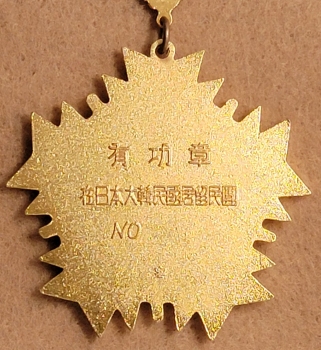
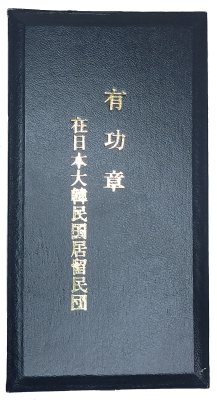
Medal of Merit 有功章 (유공장) Manufactured by Tōmei Kishō
東明徽章 (동명휘장)
The Korean Association of Japan
Mindan tends to exclude newcomers from its organization. On May 20, 2001, recent immigrants from Korea created a new organization called the Korean Association in Japan 재일본한국인연합회 (在日本韓国人連合会). Their website specifically states, “We call the Koreans who came to Japan and settled in Japan following the Korea-Japan Agreement in 1965 as newcomers.” Their website is at https://www.haninhe.com/. Although it is a national organization in Japan, only a few local branches have been established. To date, no medals from this organization have been observed.
Association of Korean Residents in Japan
Another large organization representing ethnic Koreans is the Association of Korean Residents in Japan, usually abbreviated as 총련 Chongryon 總聯 or 조선총련 Chōsen Chongryon (朝鮮総連). It is primarily composed of Zainichi (在日, literally ‘in Japan’). These are ethnic Koreans with permanent residency in Japan, whose families immigrated (often under duress) to Japan before 1945. From 1910 until the end of World War II in 1945, all ethnic Koreans were Japanese nationals. The end of the war left the nationality of Koreans in an ambiguous position, since there was no recognized functional government existing on the Korean Peninsula. Koreans residing in Japan were provisionally registered under the name of Chōsen (조선, 朝鮮), the old name of an undivided Korea. In 1948, both North and South Korea declared independence, which automatically made Chōsen a defunct nation. Koreans who held Chōsen nationality were allowed to re-register as South Korean nationals. Japan does not recognize North Korea as a legitimate government, so supporters of the North did not re-register and deliberately retained their Chōsen nationality and their status as Zainichi.
Chongryon is a far more militant organization, with a strong allegiance to North Korea and North Korean ideology. It is vehemently opposed to the full integration of Koreans into Japanese society. It is by far the most controversial Korean organization in Japan. Since there are no diplomatic relations between North Korea and Japan, the Chongryon has functioned as North Korea’s de facto embassy in Japan.
For many years, in part because of its role as the de facto embassy of North Korea, Chongryon enjoyed unofficial immunity from searches and investigations. It also held tax-exempt status on many of its real estate holdings. But starting in the early 2000s, things began to change dramatically for the Chongryon. Escalating tensions over North Korea’s nuclear weapons program (with its proximity to Japan) and its abduction of at least 13 Japanese Nationals (which the DPRK has acknowledged) has led to widespread animosity among the Japanese. Chongryon is considered by many as being a criminal organization involved in espionage, smuggling and with the illegal laundering of funds to North Korea. The Japanese authorities are cracking down on Chongryon activities, which Chongryon criticizes as acts of political suppression. Chongryon has run into escalating legal problems and severe financial trouble, with debts of over US$750 million. In 2012, Japanese courts ordered Chongryon to dispose of most of its assets, including its Tokyo headquarters. Chongryon is also suffering from a declining membership, with members switching their allegiance to the Republic of Korea Residents Union in Japan. It is believed that 65% of Zainichi are now, purportedly affiliated with the Mindan organization.
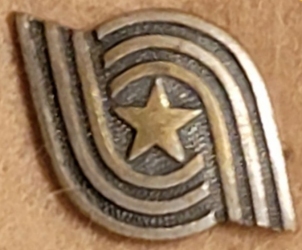
This pin is called 모범반 模範班
Exemplary (Model) Class (Social Standing)
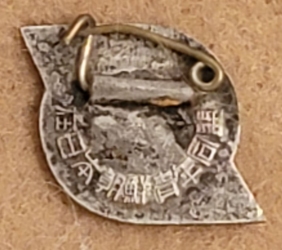
在日本朝鮮靑年同盟
(재일본조선청년동맹)
Korean Youth League in Japan
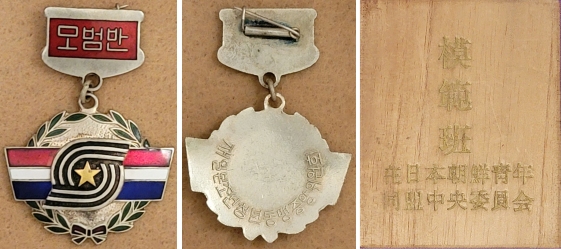
Badge reverse: 재일본조선청년동맹중앙위원회
Central Committee of the Korean Youth League in Japan
The Box Cover has the same inscriptions, but in Chinese 模範班 在日本朝鮮菁年同盟中央委員会
